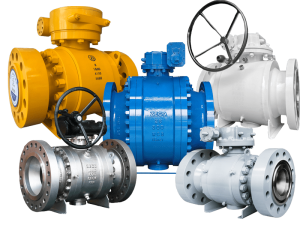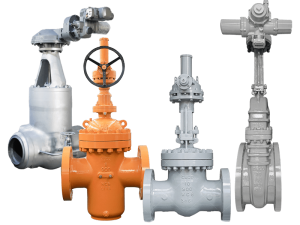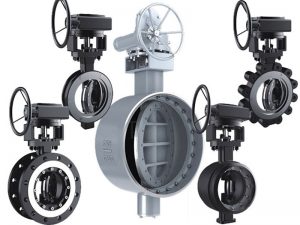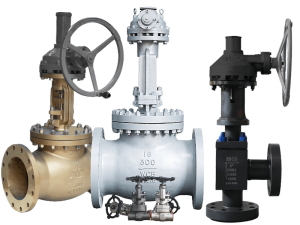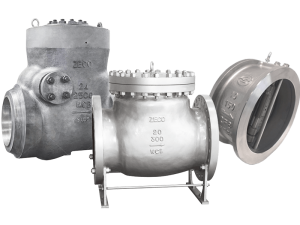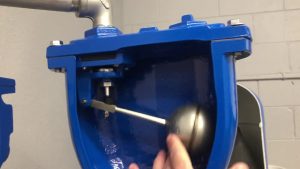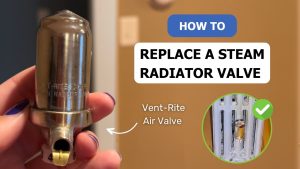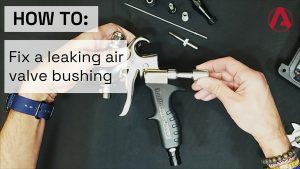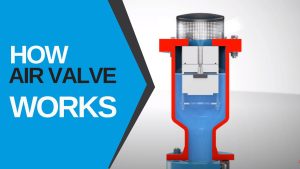What is Wafer butterfly valve?
With a Wafer valve, a longer bolt or threaded rod passes right through both flanges and the valve. This pulls the flanges together, which holds the valve in place. The Wafer type Butterfly Valve is placed between pipe flanges, and the flange bolts surround the valve body.
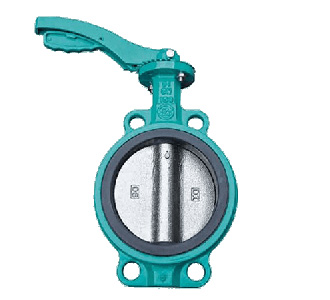
Components of Wafer Type butterfly valve
- The valve body is the component of a wafer-type butterfly valve that is used to hold the internal parts of the valve. The body is made strong using strong materials like nickel alloy, brass, carbon steel, and stainless steel, among other strong metals. The body is mounted between two flanges of the pipe. The body is also designed with a bolt head to hold the bolts that connect the pipe and the valve.
- A stem is the component of a wafer-type butterfly valve that is used to connect the disc and the handwheel/lever or actuator. The stem transmits the torque needed to turn the disc to open or close the fluid flow.
- The Valve disc is part of a wafer-type butterfly valve responsible for opening and closing fluid flow. Proper disc work is critical as it affects the efficiency of fluid flow. The disc is connected to the handwheel or actuator via the valve stem. It works by making a quarter turn to open or close the valve.
- Wafer-type butterfly valve manufacturers design these valves with two seats. The seat provides a surface for the disc to rest on when the valve is closed. This helps to prevent fluid leakage when the valve is closed. The seats are pressed, locked, or bonded onto the body. The seat is made of different materials, from metals, polymers, or elastomers.
- The actuator/ handwheel is the component of a wafer-style butterfly valve that is used to provide the torque needed to turn the stem to open the valve disc.
How does a Wafer Butterfly Valve Work?
Butterfly valves are a family of quarter-turn valves and work very similar to ball valves. The ‘butterfly’ is a disk connected to a rod. When the valve opens, the disk rotates, allowing fluid to pass through. It closes when the rod rotates the disc by a quarter turn to a position perpendicular to the flow direction.
Types of wafer-type butterfly valves
Manual wafer-type butterfly valve
This is a wafer-style butterfly valve that is operated manually. This type of valve does not have an actuator but a handwheel or hand lever. The handwheel or lever is where the valve operator applies the torque needed to rotate the stem to open or close fluid flow as necessary. One advantage of a manual wafer-type butterfly valve is that it is cheaper than the actuated type. Also, the manual type is versatile in that the user can add the actuator if necessary. Manual wafer-type butterfly valves can work when the other valves, for example, those depending on electricity, are not operational due to a lack of energy. However, manual wafer-style butterfly valves can be dangerous to the valve operator, especially when the valve is working on flammable and or acidic products, which can cause a lot of damage in case of any leakage.

Electric wafer-type butterfly valve
This is a wafer-style butterfly valve that is powered using electricity. The electricity is converted into mechanical energy. The mechanical energy provides the torque that turns the valve disc to close or open. Electric wafer-type butterfly valve manufacturers design this with an automated system determining when to close and open the valve. The automated system has different components which are powered by electricity. All the actuator parts work together to help the valve start and close fluid flow. One advantage of electric wafer-type butterfly valves is that electricity is widely available and cheap, making them suitable for use in almost all applications.
Pneumatic wafer-type butterfly valve
This wafer-type butterfly valve uses compressed air to start and stop fluid flow. Wafer-type butterfly valve manufacturers design this valve with an automated system that coordinates all the actuator parts to determine when to open and close the valve. The Actuator works by converting energy into rotary motion. The rotary motion provides the torque to turn the valve stem and the disc to open and close the fluid flow. Pneumatic wafer-type butterfly valves produce high amounts of torque due to air pressure. These valves are also durable and reliable. Having a pneumatic wafer-style butterfly valve is advantageous because the device guarantees high levels of hygiene, making it suitable for sanitary and food applications.
Hydraulic wafer-type butterfly valve
This wafer-type butterfly valve uses hydraulic fluid to start and stop fluid flow. This type of valve is suitable for applications that need a lot of torque since the hydraulic fluid produces a lot of energy due to its incompressible properties. Hydraulic wafer-type butterfly valves are reliable and smooth in operation. However, these valves are prone to temperature changes due to the hydraulic fluid.
Applications of wafer-type butterfly valves
- Wafer-style butterfly valves are used in municipal water supply systems.
- They are sued in wastewater treatment services.
- Wafer-type butterfly valves are used in slurries and sludge applications.
- They are used in gas and compressed air applications.
- They are used in fire protection systems.
- Wafer-style butterfly valves are used in oil and petroleum refinery industries.
- These valves are used in food and beverage processing plants.
- They are used in the paper and pulp manufacturing industries.
- Wafer-style butterfly valves are used in chemical processing plants.
Advantages of wafer-type butterfly valves
Wafer type butterfly valve performance advantage is that its disc is installed in the diameter direction of the pipe. The disc rotates around the axis in the cylindrical passage of the butterfly valve body, and the rotation angle is between 0° and 90°.
Summary
Wafer type butterfly valve is a type of valve used in shut-off and throttling applications. This valve operates by using a disc that rotates at an angle of 90o degrees to start or stop fluid flow. Wafer-type butterfly valve manufacturers design this valve with a manual or automatic control mechanism. The choice of handwheel or actuator depends on the customer’s preferences and the torque required to open and close the valve. A wafer-style butterfly valve is designed to allow bi-directional fluid flow. Other versions of this valve are designed to allow fluid flow in one direction only. A wafer-style butterfly valve is connected to the pipe using bolts and nuts. The valve is placed between the two ends of the pipe as the valve body is short, allowing the bolts to cross from one pipe end to the other.
Wafer-type butterfly valve manufacturers produce several types of these valves, including manual wafer-type butterfly valves, electric wafer-type butterfly valves, electric wafer-type butterfly valves, and hydraulic wafer-type butterfly valves. Applications of these valves include foods and beverages, petroleum refineries, oil and gas transportation, chemicals, paper and pulp, air gas compression systems, and water supply, among others. The advantages of using wafer-style butterfly valves are that they are simple and compact in design, less expensive, light in weight, fast in operation, and easy installation, repair, and maintenance.

